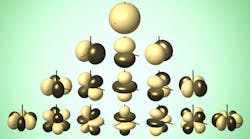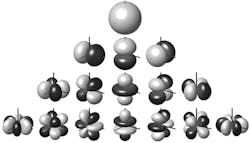In addition to channel-based audio, the Alliance system (see "MPEG-H Audio Brings New Features to TV and Streaming Sound") also includes the option of using higher-order Ambisonics components to represent the sound image instead of channels. Ambisonics components, sometimes referred to as B-format signals, are not related to speaker positions, but instead describe a sound source’s direction by means of their relative amplitudes and polarities.
One way to view these components is to consider them as coincident microphone signals of increasing complexity. The figure shows the shape or “polar pattern” of these components for orders zero to three. The zero-order component can be thought of as an omnidirectional microphone, and the first-order components as figure-of-eight microphones (such as a side-address vocal microphone) oriented along the x, y, and z axes in space.
The second and higher-order components have patterns not often seen in traditional microphones, but combine with the lower-order components in a manner similar to a Taylor or Fourier series to more accurately describe the direction of a sound or sound field. Indeed, these components form a hierarchical set of spherical harmonic basis functions.
The practical implications of using Ambisonic components is that they are independent of any speaker layout and may be used to capture a sound field using a single complex “ball” microphone. It is also possible to create Ambisonic signals artificially using a panner which samples the x, y, z values of each component. This may be used to add effects, music, or spot microphones into an Ambisonic signal.

